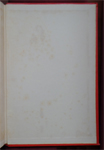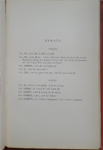100th
MP

|
THE
100th
MONKEY
PRESS |
|
|
|
Limited Editions by Aleister Crowley & Victor B. Neuburg |
|
Bibliographies |
|
Download Texts
»
Aleister
Crowley
WANTED !!NEW!!
|
|
777 |
|
Image Thumbnails |
||||||||||||||||||||||||||||||||||||||
|
Title: |
777. Vel Prolegomena Symbolica Ad Systemam Sceptico-Mysticae Viae Explicandae Fundamentum Hieroglyphicum Sanctissimorum Scientiae Summae. |
|
||||||||||||||||||||||||||||||||||||
|
Variations: |
|
|||||||||||||||||||||||||||||||||||||
|
Publisher: |
Walter Scott Publishing Co., Ltd.1 |
|||||||||||||||||||||||||||||||||||||
|
Printer: |
Ballantyne, Hanson & Co., Edinburgh & London.4 |
|||||||||||||||||||||||||||||||||||||
|
Published At: |
London and Felling-on-Tyne.4 |
|||||||||||||||||||||||||||||||||||||
|
Date: |
1909.1 |
|||||||||||||||||||||||||||||||||||||
|
Edition: |
1st Edition. |
|||||||||||||||||||||||||||||||||||||
|
Pages: |
xii +55 + ii advertisements.2 |
|||||||||||||||||||||||||||||||||||||
|
Price: |
Priced at 10 shillings.5 |
|||||||||||||||||||||||||||||||||||||
|
Remarks: |
This edition contains a loosely inserted or tipped in diagram of the Tree of Life with additional errata on the back.4 Bound-in at the rear of the book is a detachable subscription form for the Equinox.4 Crowley based this publication on the original table of correspondences compiled by Macgregor Mathers, Allan Bennett and George Cecil Jones.6 |
|||||||||||||||||||||||||||||||||||||
|
Pagination:2 |
|
|||||||||||||||||||||||||||||||||||||
|
Contents: |
|
|||||||||||||||||||||||||||||||||||||
|
Author’s Working Versions: |
|
|||||||||||||||||||||||||||||||||||||
|
Other Known Editions: |
|
|||||||||||||||||||||||||||||||||||||
|
Bibliographic Sources: |
|
|
||||||||||||||||||||||||||||||||||||
|
Comments by Aleister Crowley: |
(There is always occult opposition to the publication of important documents. It took me over three years to get my The Goetia through the press, and over two years in the case of 777. This is one of the facts whose cumulative effect makes it impossible to doubt the existence of spiritual forces.) — The Confessions of Aleister Crowley. New York, NY. Hill and Wang, 1969. Page 176. ______________________________
During my illness at Bournemouth, I wrote down from memory the bulk of Liber 777, the table of correspondences showing equivalents of the religious ideas and symbols of various peoples. Of course this rough draft needed considerable revision and additions. It was in fact two years in the press. But it stands today as the standard book of reference on the subject. I must admit to be thoroughly dissatisfied with it. It is my eager wish to issue a revised edition with an adequate comment and a key to its practical use. I refuse to feel any satisfaction at knowing that, published at ten shillings, it is now quoted at three pounds fifteen shillings as a minimum. — The Confessions of Aleister Crowley. New York, NY. Hill and Wang, 1969. Page 504. ______________________________
I had no books of reference at Bournemouth, and it struck me that it would be very convenient if I possessed a volume giving all the correspondences of the Cabbala in a compact form. I spent a week in writing this down from memory and the result is Liber 777. — The Confessions of Aleister Crowley. New York, NY. Hill and Wang, 1969. Page 533. ______________________________
I continued my researches in many other lines of Magick, from the preparation of a new edition of Liber 777 with an elaborate explanation of each column and a further analysis of the Yi King, to such matters as the critical observation of success in the Operation of the IX° O.T.O. — The Confessions of Aleister Crowley. New York, NY. Hill and Wang, 1969. Page 923. |
|||||||||||||||||||||||||||||||||||||
|
Reviews: |
Despite its cumbrous sub-title and high price per page, this work has only to come under the notice of the right people to be sure of a ready sale. In its author’s words, it represents “an attempt to systematise alike the data of mysticism and the results of comparative religion,” and so far as any book can succeed in such an attempt, this book does succeed; that is to say, it condenses in some sixty pages as much information as many an intelligent reader at the Museum has been able to collect in years. The book proper consists of a Table of “Correspondences,” and is, in fact, an attempt to reduce to a common denominator the symbolism of as many religious and magical systems as the author is acquainted with. The denominator chosen is necessarily a large one, as the author’s object is to reconcile systems which divide all things into 3, 7, 10, 12, as the case may be. Since our expression “common denominator” is used in a figurative and not in a strictly mathematical sense, the task is less complex than appears at first sight, and the 32 Paths of the Sepher Yetzirah, or Book of Formation of the Qabalah, provide a convenient scale. These 32 Paths are attributed by the Qabalists to the 10 Sephiroth, or Emanations of Deity, and to the 22 letters of the Hebrew alphabet, which are again subdivided into 3 mother letters, 7 double letters, and 12 simple letters. On this basis, that of the Qabalistic “Tree of Life,” as a certain arrangement of the Sephiroth and 22 remaining Paths connecting them is termed, the author has constructed no less than 183 tables.
The Qabalistic information is very full, and there are
tables of Egyptian and Hindu deities, as well as of colours,
perfumes, plants, stones, and animals. The information
concerning the tarot and geomancy exceeds that to be found in
some treatises devoted exclusively to those subjects. The author
appears to be acquainted with Chinese, Arabic, and other classic
texts. Here your reviewer is unable to follow him, but his
Hebrew does credit alike to him and to his printer. Among
several hundred words, mostly proper names, we found and marked
a few misprints, but subsequently discovered each one of them in
a printed table of errata, which we had overlooked. When one
remembers the misprints in “Agrippa” and the fact that the
ordinary Hebrew compositor and reader is no more fitted for this
task than a boy cognisant of no more than the shapes of the
Hebrew letters, one wonders how many proofs there were and what
the printer’s bill was. A knowledge of the Hebrew alphabet and
the Qabalistic Tree of Life is all that is needed to lay open to
the reader the enormous mass of information contained in this
book. The “Alphabet of Mysticism,” as the author says—several
alphabets we should prefer to say—is here. —The Occult Review, G.C.J., date unknown. ______________________________
No Buddhist would consider it worth while to pass from the crystalline clearness of his own religion to this involved obscurity. Some of the language is extremely undignified. —The Buddhist Review, date unknown.
|
|||||||||||||||||||||||||||||||||||||











